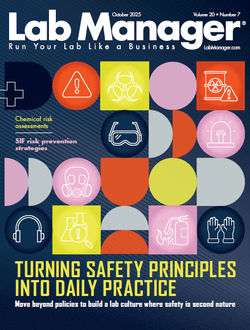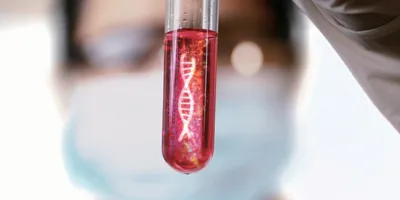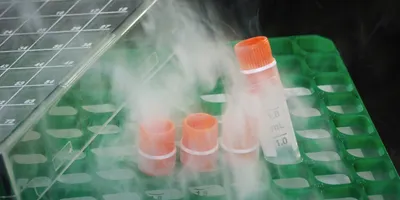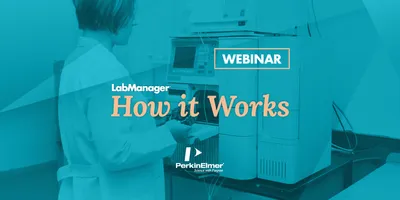 Headquartered in the Livermore Valley in Northern California, the National Food Lab (NFL) is more than just a food and beverage testing facility.
Headquartered in the Livermore Valley in Northern California, the National Food Lab (NFL) is more than just a food and beverage testing facility.
“We really are a full-service research and consulting company for the food industry, starting with developing new ideas through marketing [and] with our product development group,” says Julie Hill, vice president of the NFL’s chemistry division.
She adds that the facilities include a chef to bring in culinary ideas, a sensory group to evaluate the sensory properties of the product, and a consumer group to evaluate the consumer acceptability of a product. The facility also includes food safety, microbiology, and chemistry divisions. “I head up the chemistry group and handle things that shouldn’t be in food, [such as] pesticide residues, and also things that should be in food,” Ms. Hill says, adding the facility is focused on food manufacturers rather than on individuals.
“We’re so food company-focused … that often we [do] the testing for them, [so] if it ever went to a dispute, there would be conflict-of-interest issues if we did work for consumer groups or individuals,” she explains. “So we kind of shy away from that.”
That was a good thing in the case of a strange request from one individual.
“We didn’t take this one, but we do get individuals calling us on occasion, and the strangest request was to test someone’s food because it was making [the person] sing like Elvis,” Ms. Hill says, adding with a laugh, “I couldn’t make up that one.”
Inside the chemistry division
There are 155 employees in the NFL—some of whom are part-time staff— and about 35 of the employees belong to the chemistry division. All those staff have college degrees, most in either chemistry or food science or some aspect of microchemistry or biochemistry, Ms. Hill says. The NFL also has a full training program for new staff.
 The NFL’s main instrument lab where chemists can easily collaborate on method development and problem solving.“It’s more of a co-worker training program—‘see one, do one, teach one,’” Ms. Hill explains. “There is [also] some opportunity to go outside and do some vendor training and go to events like [the IFT’s (Institute of Food Technologists’) Annual Meeting & Food Expo] or other meetings. We’re trying to do more of that now than we have in the past.”
The NFL’s main instrument lab where chemists can easily collaborate on method development and problem solving.“It’s more of a co-worker training program—‘see one, do one, teach one,’” Ms. Hill explains. “There is [also] some opportunity to go outside and do some vendor training and go to events like [the IFT’s (Institute of Food Technologists’) Annual Meeting & Food Expo] or other meetings. We’re trying to do more of that now than we have in the past.”
Those 35 employees are kept busy analyzing an average of 50,000 to 75,000 samples a year while usually handling about 500 client projects from the 5,000 customers the NFL has in its database at any one time, she explains.
That large amount of work is kept manageable through the organization of the chemistry division, with specific employees focused on specific tasks—the sample control group, for example, is responsible for and handles all incoming samples.
“They make sure the paperwork that’s sent with the samples is correct, tests have been identified, and products’ sample codes are identified correctly,” Ms. Hill says, adding the group also deals with clients on any issues that might come up as samples arrive at the facility.
If the sample control group is uncertain about how to handle an item, it is sent to the project leader, who also handles any technical issues that arise. After the sample control group is through with them, samples are sent to the individual chemist to run tests; the results are compiled and then sent to the client service group, who are responsible for getting the final report to the client and handling any requests clients have.
“Everybody handles his or her piece of the stream, so it just makes it easier if you really know your piece and handle that well,” Ms. Hill says.
A typical two weeks
That whole process begins with the samples arriving every day at 10:00 a.m. by FedEx or UPS. All the boxes are opened, and the samples and paperwork are inspected. The samples are logged into the lab’s PerkinElmer Labworks LIMS program, and the paperwork is distributed to the chemists. The LIMS program is also used for test data and final reports.
While the NFL’s microbiology department starts testing each sample they get that same day, because the chemistry department might get only one kind of a sample a day, they have to batch their samples over a longer time, Ms. Hill explains.
“It’s just not cost-effective to run just one vitamin C, [for example],” she says. “We take in a bunch over a [longer] time period and batch [the samples] over a one- or two-week time period, depending on the turnaround time needs.”
The analysts prioritize which samples need to be done first, and batched samples are then run all at once, with the testing broken up into sample preparation and analysis stages. Technicians prepare the samples, and then it’s up to the chemists to run them on the instruments.
“Those [samples] are usually prepared midday and then put on the instruments at night,” Ms. Hill says. “The next morning, the analysts will pull them off the instruments, interpret the results, do all the calculations, and do all the quality control charts. Then, if the data passes all the QC requirements, it goes to second review.”
 A typical day extracting pesticide out of food samples.Once that stage is complete, the results go to the client service group, who compile all the data into a report that is passed to the project leader for final approval of the entire project and finally emailed to the client.
A typical day extracting pesticide out of food samples.Once that stage is complete, the results go to the client service group, who compile all the data into a report that is passed to the project leader for final approval of the entire project and finally emailed to the client.
“And we do that over and over and over,” Ms. Hill laughs.
As for instrumentation, the chemistry department uses HPLC, autotitrators, protein analyzers, and moisture ovens to do its food chemistry tests, which determine components such as vitamin C that are found naturally in foods.
For testing for things that shouldn’t be in food (pesticides, heavy metals, etc.), the chemistry division uses more advanced equipment such as LC-MS-MS, GC-MS-MS, and ICP-MS, with Thermo Fisher Scientific, Agilent, and PerkinElmer making up the three main brands they use in the whole division.
The tough stuff
For Ms. Hill, balance is one of the major challenges in the chemistry division.
“The biggest challenge is assessing the capability of the lab, making sure that we’re challenging the lab and the staff but not getting so over our heads that we’re doomed to fail,” she says.
She adds that her 25 years of experience in the industry—24 of them with the NFL—have helped her better understand which projects her division can handle and which it can’t.
“I’ve been doing this for a long time, so I know what project is going to be too much,” Ms. Hill says. “I’ve been burned a few times and lost sleep over projects, and I don’t like to do that.”
 Technician extracting fat for food using the traditional soxlet method.The greater awareness of food safety in recent years, with food safety problems getting into the press and to the public much faster than before, has created another tough challenge for the NFL, as it has also sped up the turnaround time for results, she adds.
Technician extracting fat for food using the traditional soxlet method.The greater awareness of food safety in recent years, with food safety problems getting into the press and to the public much faster than before, has created another tough challenge for the NFL, as it has also sped up the turnaround time for results, she adds.
“Twenty years ago, when I started, that didn’t happen,” Ms. Hill says. “It wasn’t blasted out as fast. It’s good for [our] business, but I think that’s been a big change even in the last five years.”
She adds that new government regulations have contributed to that greater awareness of food safety.
“It has a big impact on the testing industry; if a new regulation goes into effect, it just ups the awareness of doing testing,” Ms. Hill explains. “For example, the Food Safety Modernization Act (FSMA) is playing a big role.”
Despite her involvement with food in her work, she says she doesn’t really have a favorite food.
“I’m a believer in a little bit of everything and not a lot of any one thing,” Ms. Hill says. “I think you get into trouble when you eat a lot of one product, because if it is contaminated, then you are exposing yourself.”
However, she adds she does have a least favorite food after a certain test in the lab.
 Varian Triple Quad 320 Gas Chromatograph Mass Spectrometer/Mass Spectrometer, the NFL chemistry department’s work horse.“We tested fried chicken for fat one time, and it was over 25 percent fat,” she says. “I just saw the amount of fat that was in the beaker—I haven’t really eaten fried chicken since.”
Varian Triple Quad 320 Gas Chromatograph Mass Spectrometer/Mass Spectrometer, the NFL chemistry department’s work horse.“We tested fried chicken for fat one time, and it was over 25 percent fat,” she says. “I just saw the amount of fat that was in the beaker—I haven’t really eaten fried chicken since.”
Staying motivated
As for the best part of her job, Ms. Hill says the successes are what make the challenges worthwhile.
“When we get it right, whatever that ‘right’ is—whether we win a project … or if we pass our proficiency samples so we get the same results as another laboratory,” she says are what she enjoys most about her job. “When we get it right, it’s a reward for everyone; it means we’re doing our job correctly.”
She adds that her staff also seems to be motivated by the “wins” as well, so she makes sure they get to hear that they won a project or that test results were what were expected. Putting family first is another benefit of working at the NFL.
“We’re a very family-oriented business where we have flexible hours.” Ms. Hill says. “I think between those two [the wins and flexible hours], they seem to be a pretty happy staff. But I think we need to do more; there’s definitely more investigation [needed] into what really does motivate them instead of just assuming.”
The lab’s future
Currently, the lab is in the final stages of getting its ISO accreditation, something it has been working on for the past 18 years, Ms. Hill says.
“It’s always been in the back of my mind; every time we’ve [developed] any kind of quality program in place at the lab, we’ve always based it on ISO, so [we’ve been] pointing in that direction all along,” she says. “[It has finally become] a financial incentive to be an ISO lab. Our clients were starting to ask for it, but the basis of our quality program has always been ISO.”
The NFL had its audit on April 9, and Ms. Hill expects the whole process to be complete around September.
Further into the future, she says the lab doesn’t expect to change too much but is hoping to do more consulting work versus the straight testing of samples, though those possible changes are still just in the strategic planning stage.
“We like to work with food manufacturers in helping them develop their programs, doing validation of their processes, [such as how, for example, they should cook their] rice crackers to make sure there’s no Salmonella in the rice that will eventually [get] in the final product.”
Main Instruments:
• Thermo Fisher TRACE TSQ Quantum XLS Gas Chromatograph Mass Spectrometer/Mass Spectrometer equipped with autosampler
• Varian Triple Quad 320 Gas Chromatograph Mass Spectrometer/Mass Spectrometer equipped with UV detector and autosampler
• Varian Saturn 2200 GC/MS/MS equipped with 3400CX GC, Ion Trap Mass Spectrometer Detector, Solid Phase Micro-Auto-Extractor, and 1078 Cryo Injector
• Thermo Fisher TSQ Quantum Ultra triple quad Liquid Chromatograph Mass Spectrometer/Mass Spectrometer equipped with autosampler
• Varian Triple Quad 320 Liquid Chromatograph Mass Spectrometer/Mass Spectrometer equipped with autosampler
• PerkinElmer NexION 300X Inductively Coupled Plasma/ Mass Spectrometer









